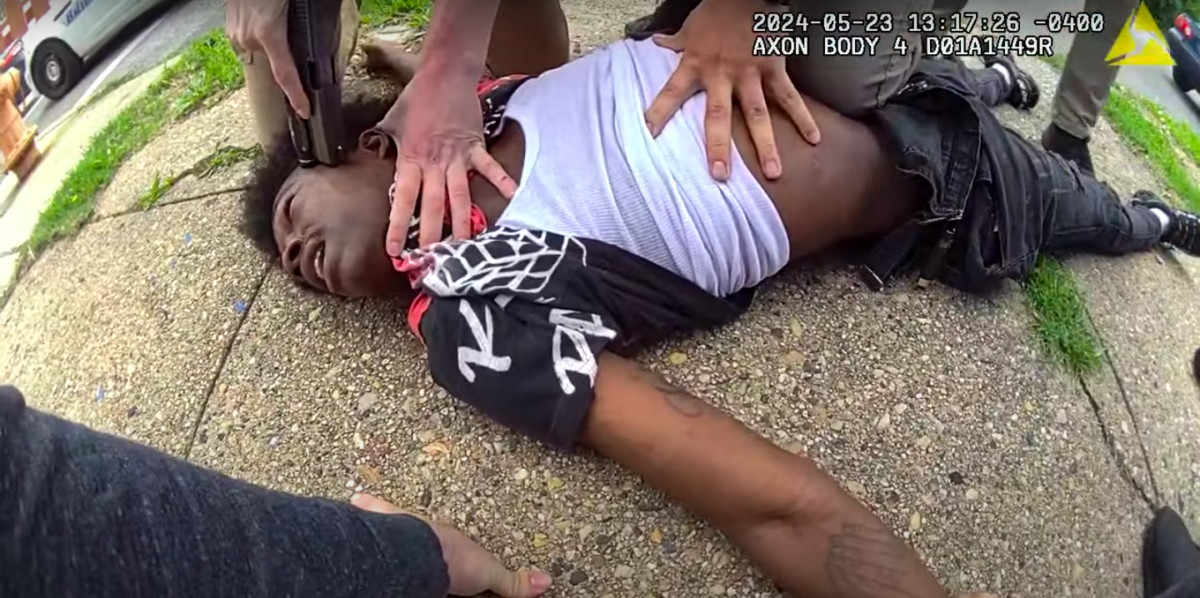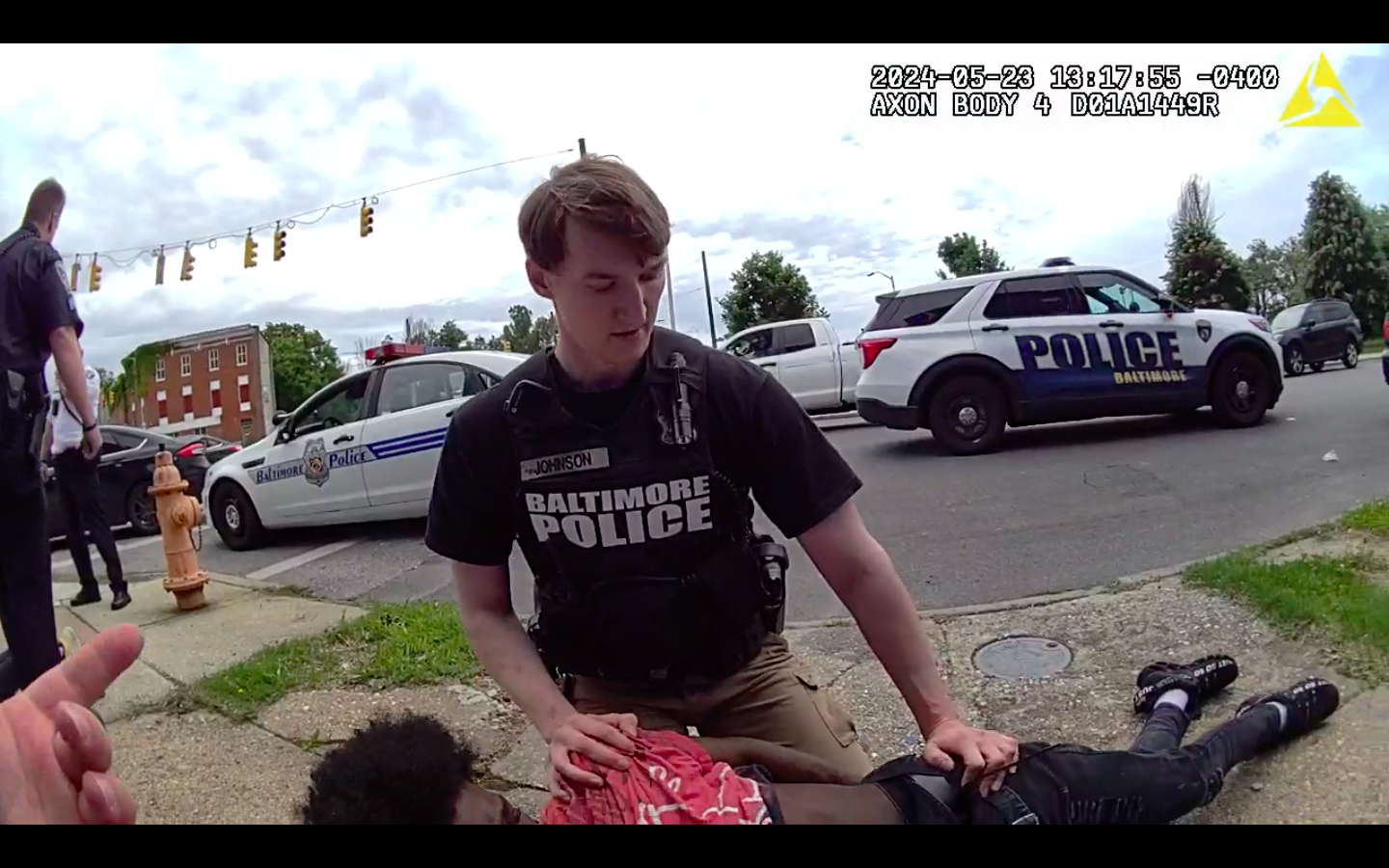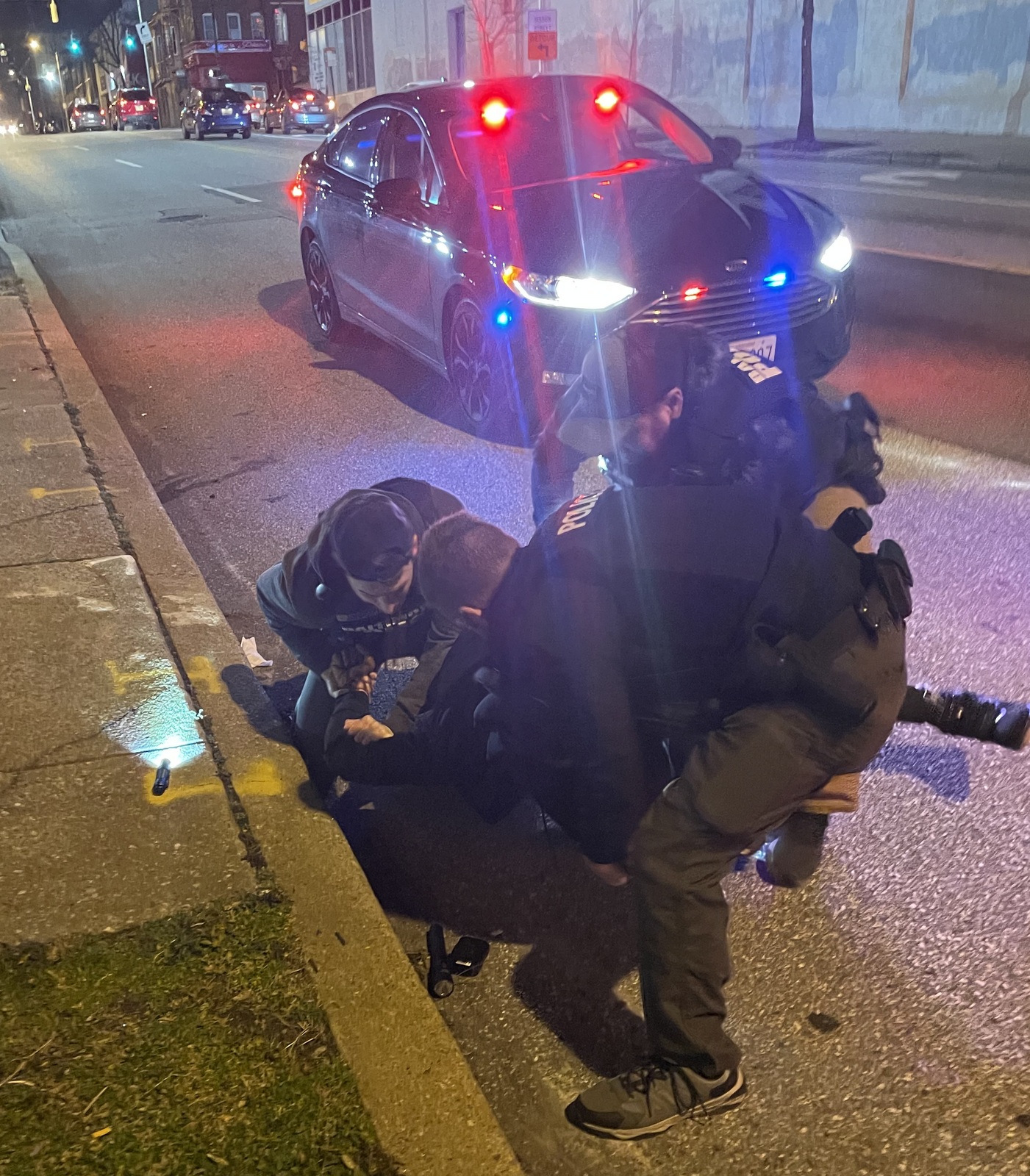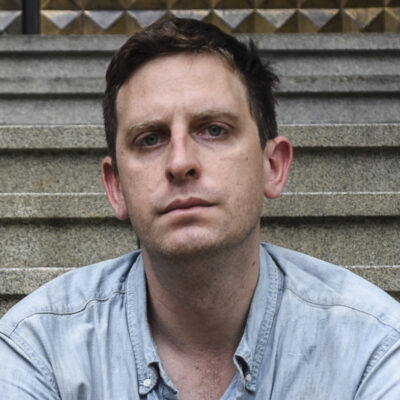
[Editor’s Note: This story was produced in partnership with the Garrison Project, an independent, nonpartisan organization addressing the crisis of mass incarceration and policing. Explore more of the project’s coverage, here.]
On September 5, the Baltimore City State’s Attorney’s Office announced that it would not pursue criminal charges against BPD detective Connor Johnson, who pressed his service weapon against the temple of a restrained and prone Baltimore man during a controversial May arrest.
In July, WBAL-TV obtained body-worn camera footage of the incident and broadcast it, leading to a demand from the Police Accountability Board for Baltimore City that Johnson be suspended and required to undergo de-escalation and appropriate use of force and firearm training.
“It is unfortunate that in a city currently under consent decree that we have officers that would act so recklessly,” Accountability Board chair Joshua Harris, a former candidate for mayor, said in a statement at the time. “I am sure that nowhere in the officer training is it justifiable to point a gun at point blank range at the temple of an already subdued suspect.”
Baltimore Police Commissioner Richard Worley defended Johnson shortly after the incident, saying he was “out there doing his job.” The Baltimore Police Department (BPD) has said Johnson was under investigation, but that he has not been suspended from the force.
Meanwhile, an examination by The Garrison Project and Baltimore magazine of body-worn camera footage and reports filed by officers involved in the arrest of Jaemaun Joyner—including the statements of charges and probable cause—raise other questions about the incident as well as broader concerns about the BPD’s aggressive, plainclothes District Action Team.
Just after 1 p.m. on May 23, a group of Baltimore City police officers, including Johnson, stopped Joyner in front of a corner bodega in the East Baltimore neighborhood known as Broadway East. Two of the five officers—including Johnson—are members of the department’s District Action Team, or DAT. DAT is an approximately 80-person unit created in 2017 after the BPD disbanded its now-infamous Gun Trace Task Force.
Following a reported robbery in the area, officers searched for an individual matching the description of the suspect: a six-foot Black male wearing a brown hoodie and a ski mask. Joyner, a 24-year-old Black man, who stands roughly 5-feet-7 inches, was wearing a red and black shirt when he was first grabbed by DAT officer Austin Gutridge.
“What’d I do?” Joyner can be heard asking in the body-camera footage of his arrest.
He tried to run, but was quickly tackled by detective Phil Polanco. Four officers then held Joyner down on the sidewalk.
“He’s reaching for something!” detective Christian Agard screamed.
“I ain’t reaching for nothing,” Joyner responded.
One of the detectives pressed his knee into the chest of Joyner, who can be heard gasping; he once had a collapsed lung, according to his family.
“I can’t breathe,” Joyner said.
Officers pinned Joyner’s arms and torso. He began to squirm and shout. They reached into his pockets.
“What’d you just put in my pocket?” Joyner said.
Johnson then put one hand around Joyner’s neck and took out his service weapon, putting the barrel of the Glock 22 to Joyner’s temple.
“He put something in my pocket,” Joyner screamed as Johnson held his gun to his head.
About six seconds later, Johnson pulled the handgun away from Joyner’s head. Joyner was then handcuffed.
Joyner was charged with handgun possession, possessing a loaded handgun, and drug possession. After spending 54 days in jail, all of those charges were dropped by the City State’s Attorney’s Office.
Even though the charges against Joyner were dismissed and there was public condemnation over the arrest footage, the nearly two months in jail forced him to miss an early June start date for a new job. Joyner’s attorney Hunter Pruette described the stop and Johnson’s conduct as “outrageous.”
“You have a young man who’s walking down the street and minding his own business, trying to move about his day, and the police jump out on him for no reason. They give him no explanation,” Pruette told The Garrison Project and Baltimore magazine. “He’s complaining he can’t breathe, saying something about they put something in his pocket, and the next thing you know, there’s a hand on his neck and a gun to his temple.”
In the statement of probable cause, officers described Joyner and a friend who was detained but not arrested as “two suspects that match the description of an armed robbery that just occurred.” Joyner, however, did not match the suspect description of a Black man in a brown hoodie. He was, as noted in the report, wearing, “a black jacket, red shirt, [and] a black romper suit.”
Indeed, at the scene of Joyner’s arrest the victim told police that Joyner was not the person who robbed him. Nonetheless, according to Joyner’s attorneys, the police account made it seem as though Joyner was still a suspect in the robbery when he was brought to the ground and detained.
“The investigation for the armed robbery is still ongoing,” Polanco, the officer who initially tackled Joyner, wrote in his subsequent report.
The statement of probable cause also entirely omitted that Johnson held a gun to Joyner’s head. “Detective Agard observed Mr. Joyner reaching for his right pocket and advised detectives on scene,” Polanco wrote. “This detective observed what appears to be a handgun in Mr. Joyner’s right pants pocket. Detective Gutridge retrieved a Phoenix HP22A handgun.”
Jessica Rubin, one of Joyner’s attorneys, said the body-worn camera footage shows a clear violation of the Consent Decree. “This was excessive force,” Rubin said in a recent interview. “And there was actually another officer with his hand on his service weapon, as well. When you have [Joyner] restrained like that, I don’t see how that many police officers could feel like they were in danger.”
Defense attorney Pruette said BPD Commissioner Worley’s defense of the incident—“If you’ve ever been fighting with a guy who has a gun and he’s trying to free his hands, then you try to do whatever you can to get him in custody”—represents the “’you must do as we say, because we’re the police’ mentality. Quite frankly, he’s an old school commissioner and these are the tactics that he grew up with, right? And these tactics terrorize people.”

The Baltimore City Police Department’s District Action Team has faced other allegations of misconduct and excessive force.
In May 2023, Cedric Elleby, a DAT officer southwest in Baltimore shot a 17-year-old boy when he ran from officers. The BPD said “the officer observed him pull out” a gun and Elleby discharged his weapon. They said they later recovered a stolen 9mm Smith & Wesson. Elleby was placed on administrative leave. The State’s Attorney’s Office later said it would not charge him in the incident.
That June, Johnson and other DAT officers, including Gutridge, shot and killed a 40-year-old Black man named Daryl Gamble (the detectives were later cleared in Gamble’s killing.) In November, DAT officers shot and killed 27-year-old Hunter Jessup.
The Garrison Project and Baltimore magazine obtained police reports and other investigative documents from another gun and drug case involving Johnson and Guttridge from around the time they killed Gamble in June 2023.
A month prior, on May 25, 2023, Johnson, Gutridge, and detective Zachary Allman stopped A.A. (whose name is being withheld for privacy concerns*) for a broken tail light. When the officers approached the car, Gutridge claimed he could smell cannabis. While A.A. got his registration, Gutridge and others peered into his vehicle.
Allman told A.A. to open his passenger side window. Johnson looked in the car. “There’s definitely some shake [loose marijuana] on that seat,” Gutridge told Johnson.
A.A. was removed from the car. But body-worn camera footage shows no “shake” on the car seat. The officers asked if they could search the car and he said no. They asked again and he refused again. The officers searched the car anyway, telling A.A. that the cannabis smell meant they didn’t need his consent. But there was no cannabis in the car. Instead, the officers said they found a small amount of cocaine in his pocket and a handgun in the glovebox.
A.A.’s lawyer argued that the DAT members did not have probable cause or consent to search the car.
“Three high-ranking officers were attending to a non-criminal traffic stop of a car with a single occupant inside. Within 90 seconds, that occupant provided law enforcement with all of the information necessary to run his documents and complete the mission of the stop expeditiously,” reads a motion to suppress by A.A.’s attorney. “Upon receipt of these documents, [DAT] prolonged the stop by urging the driver to open the passenger window to enable another detective to investigate the car’s interior, without reasonable suspicion that evidence of a crime would be located therein.”
The State’s Attorney’s Office dismissed the charges against A.A. before a judge could rule on the motion.
Last month, members of DAT were investigating a shooting in West Baltimore when they spotted 17-year-old William Gardner. DAT officer Zachary Allman—who was also present for A.A.’s arrest—chased Gardner as other detectives followed in their car. Gardner was shot and killed by three detectives from another BPD plainclothes unit, the Group Violence Unit or GVU. Police said Gardner, who did not fire his weapon, had aimed his gun at officers. He was shot a dozen times, prompting outrage from some residents in the neighborhood where Gardner lived and was killed.
An investigation initiated in April by the Baltimore Police’s Public Integrity Bureau into DAT officers Antonio Queen and Trevor Hinton led to the suspension of their police powers. The investigation is ongoing and both detectives are working administrative duties.
Last year, The Garrison Project reported that DAT officers have been investigated more than 700 times, including 410 investigations for use of force and 257 Internal Affairs investigations. There have also been 21 Civilian Review Board investigations into DAT members and nine civil lawsuits. That story highlighted the case of Shogun and Julie Dowling, a couple stopped by Det. Connor Johnson on their way to a January 2023 Ravens-Steelers game.
Johnson said after the stop that he saw a bag containing cannabis in the backseat of the couple’s vehicle. He and other DAT officers got the Dowlings out of the car and searched it, and Shogun subsequently was charged with several drug and gun charges. But Dowling’s attorney argued in a motion that “the police did not have reasonable articulable suspicion to stop or search [Dowling] and “did not have probable cause to seize or arrest [him]” making “the search and seizure…invalid.”
Dowling’s charges were dismissed by the State’s Attorney’s Office. Shogun was later reindicted on federal charges, and he entered a guilty plea to one count of possessing ammunition while being a prohibited person; he is set to be sentenced in October.

Baltimore defense attorneys say that the District Action Team’s tactics recall the unit they replaced, the Gun Trace Task Force. In 2017, eight GTTF members were charged with racketeering, robbery, extortion, and overtime fraud. Six of the eight GTTF members pleaded guilty to various charges. The remaining two were convicted at trial in federal court in 2018. More commonplace GTTF misconduct was stopping people without a reasonable articulable suspicion or probable cause.
Baltimore City District Public Defender Marguerite Lanaux said that the DAT exhibits the kind of “behavior that the consent decree intended to eradicate” and reintroduces many of the problems defense attorneys witnessed during the Gun Trace Task Force scandal.
“The public facing messaging continues to be that, [post-Freddie Gray], this type of policing was ended and the bad actors rooted out. That messaging doesn’t translate for the encounters our clients are experiencing,” Lanaux said. “We’re seeing the same things from the same officers in this same type of unit over again and we’re seeing these kinds of cases prosecuted.”
Deborah Katz Levi, director of Special Litigation for the Maryland Office of the Public Defender, said that her office “spends a lot of time focusing litigation on DAT officers’ Internal Affairs files because the behavior coming out of the DAT units is so troublesome.”
“Anecdotally, we’re seeing lots of questionable stops and what appears to be falsely generated reasons for stops,” Levi continued. “We’re definitely seeing old school ways showing up again.”
For Joyner and his family, the connection between DAT and GTTF is even more direct. Joyner’s family and his attorneys say his older brother was arrested by GTTF detective Daniel Hersl. In 2018, Hersl was sentenced to nearly two decades in federal prison for racketeering conspiracy and racketeering offenses, including overtime fraud and robbery. According to Joyner’s family, Hersl’s questionable stop and search of Joyner’s brother caused his case to be dismissed post-conviction.
The family was later approached by the FBI about testifying against Hersl during his federal trial, but chose not to, defense attorney Tony Garcia said.
Garcia, for one, believes it’s “wrong” that the City State’s Attorney’s Office did not bring criminal charges against Johnson, adding that claims of reforms and increased accountability “ring hollow” after the incident. “The state chose not to bring charges without ever talking to my client,” he said.
“I think the family is appalled,” Garcia said. “Because this isn’t the first run in with the police. This family was victimized by the Gun Trace Task force. This is their second run. They’re very disappointed that this officer will not be held accountable—and neither will the officers who saw what happened and failed to report it.”
*The Garrison Project and Baltimore magazine obtained the police reports on the May 25, 2023 arrest by Johnson, Gutridge, and Allman but anonymized the defendant as “A.A” because his attorneys could not reach him in order to gain his permission to use his name for this story.
